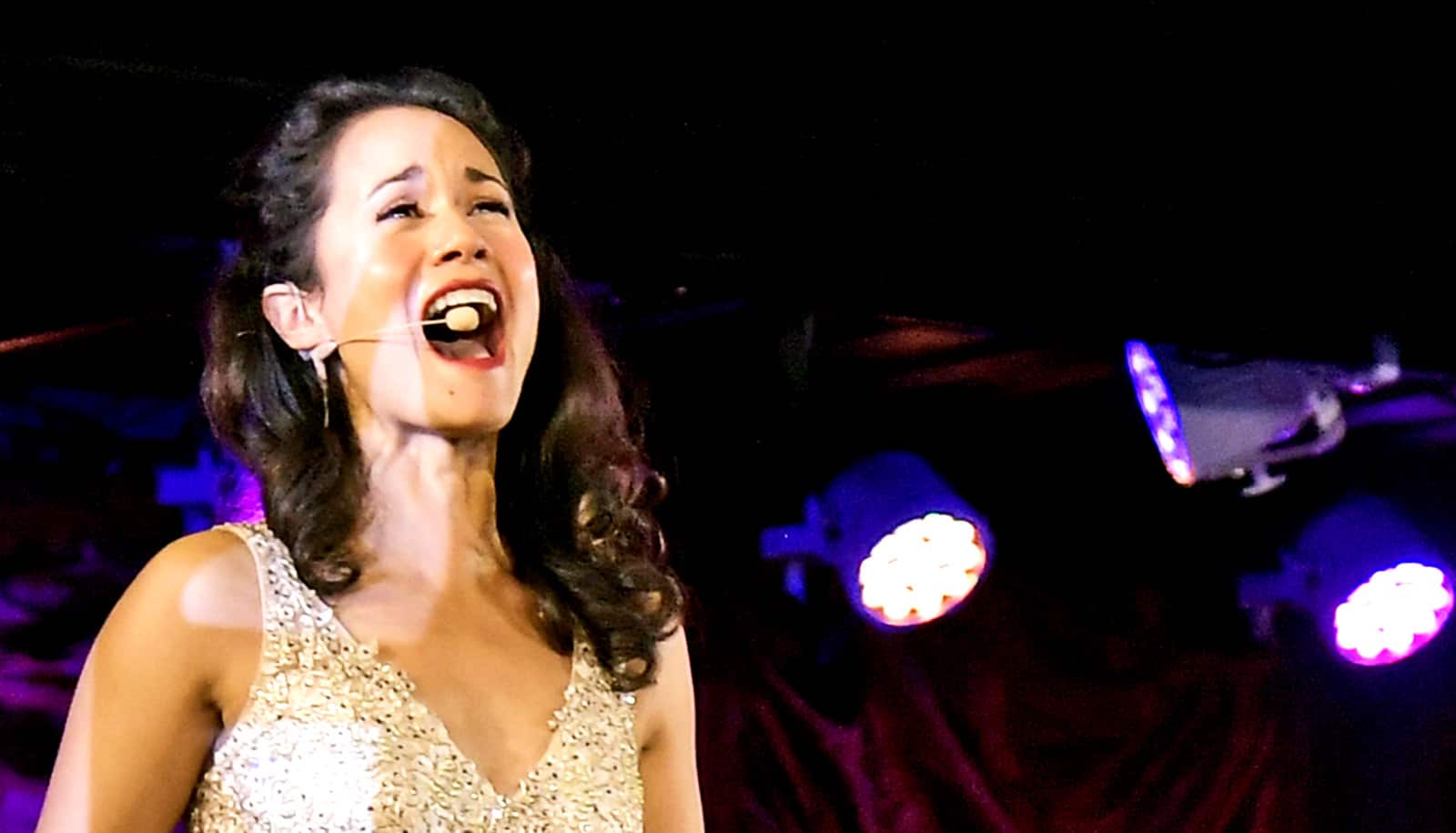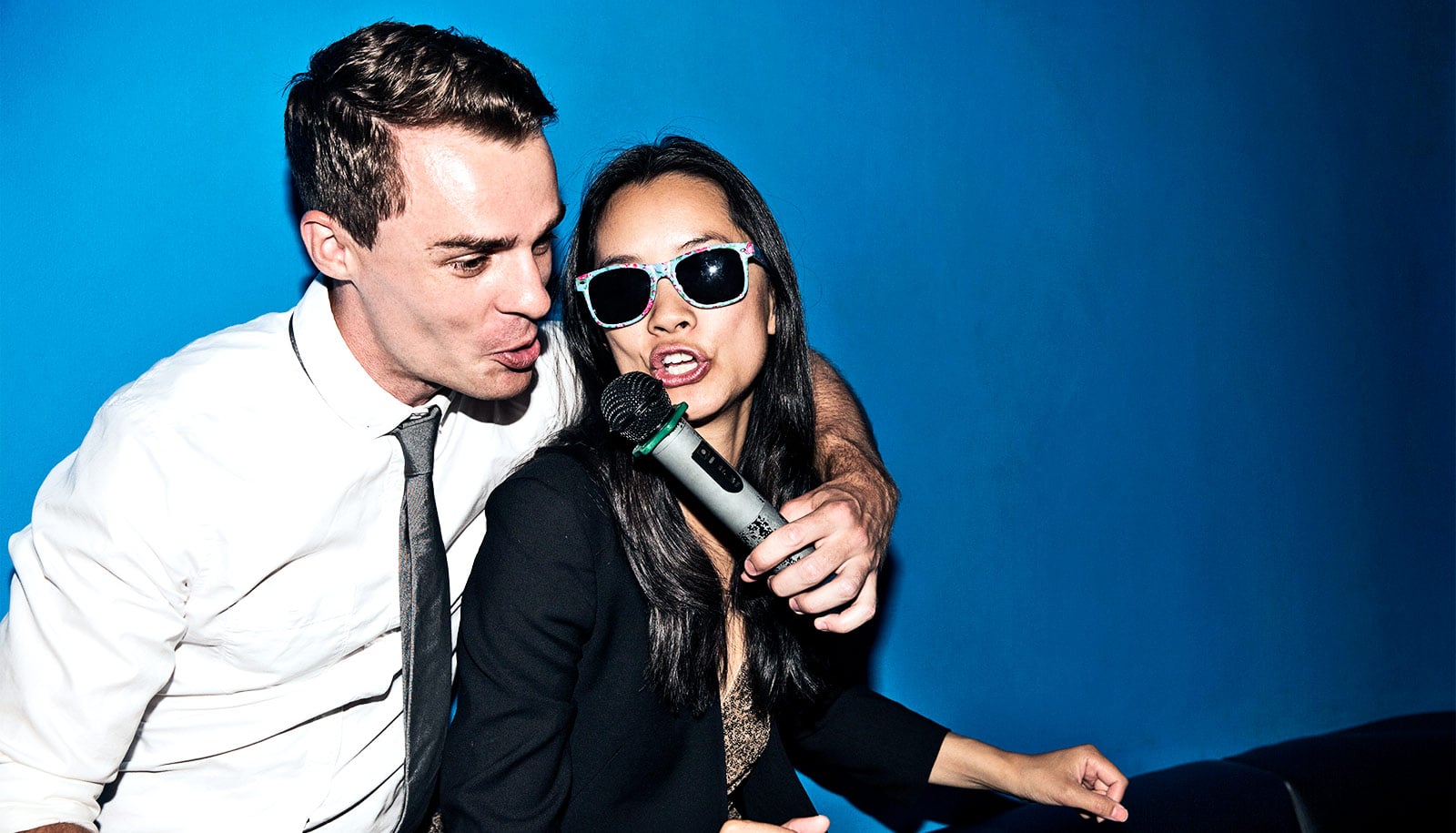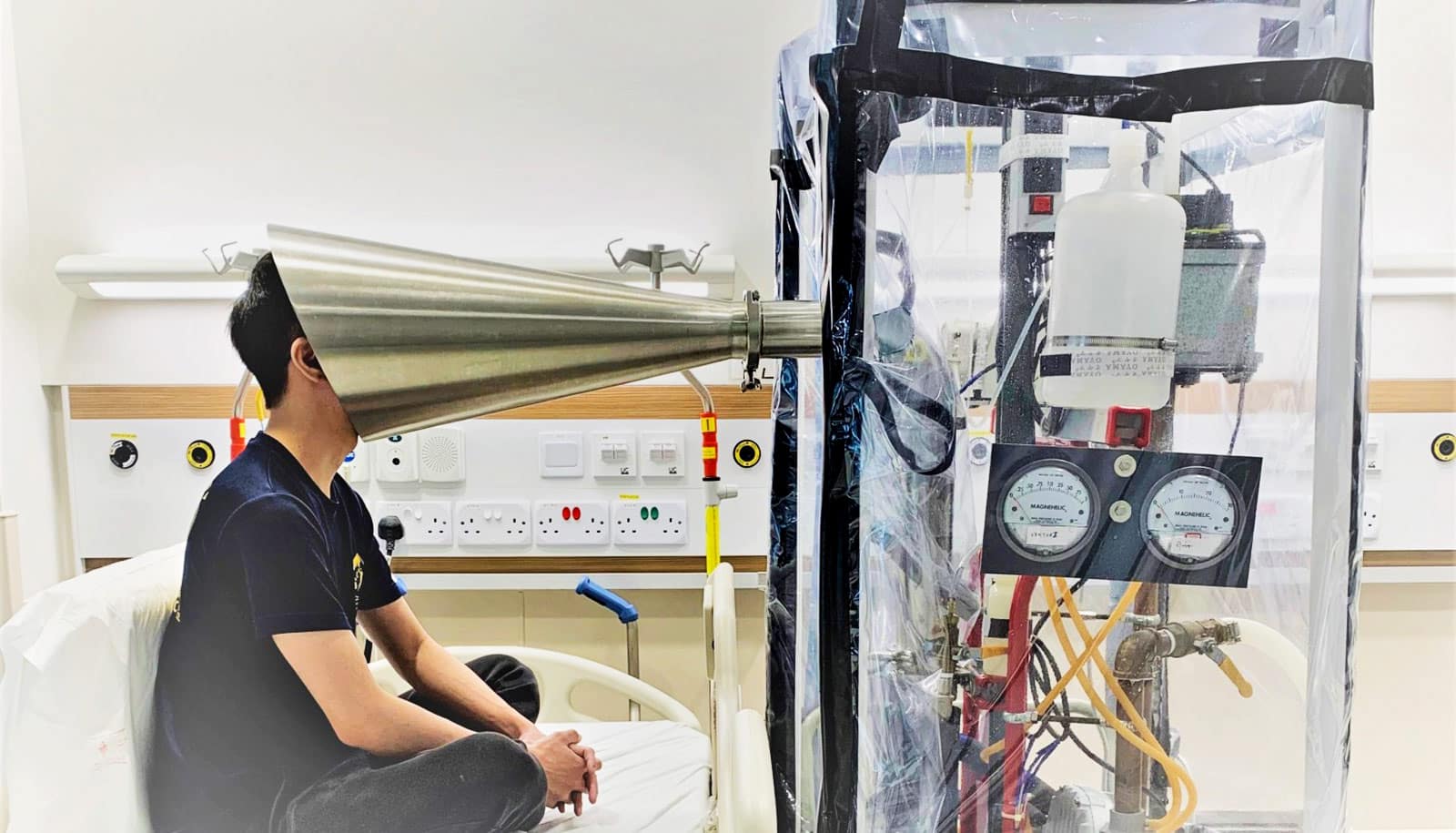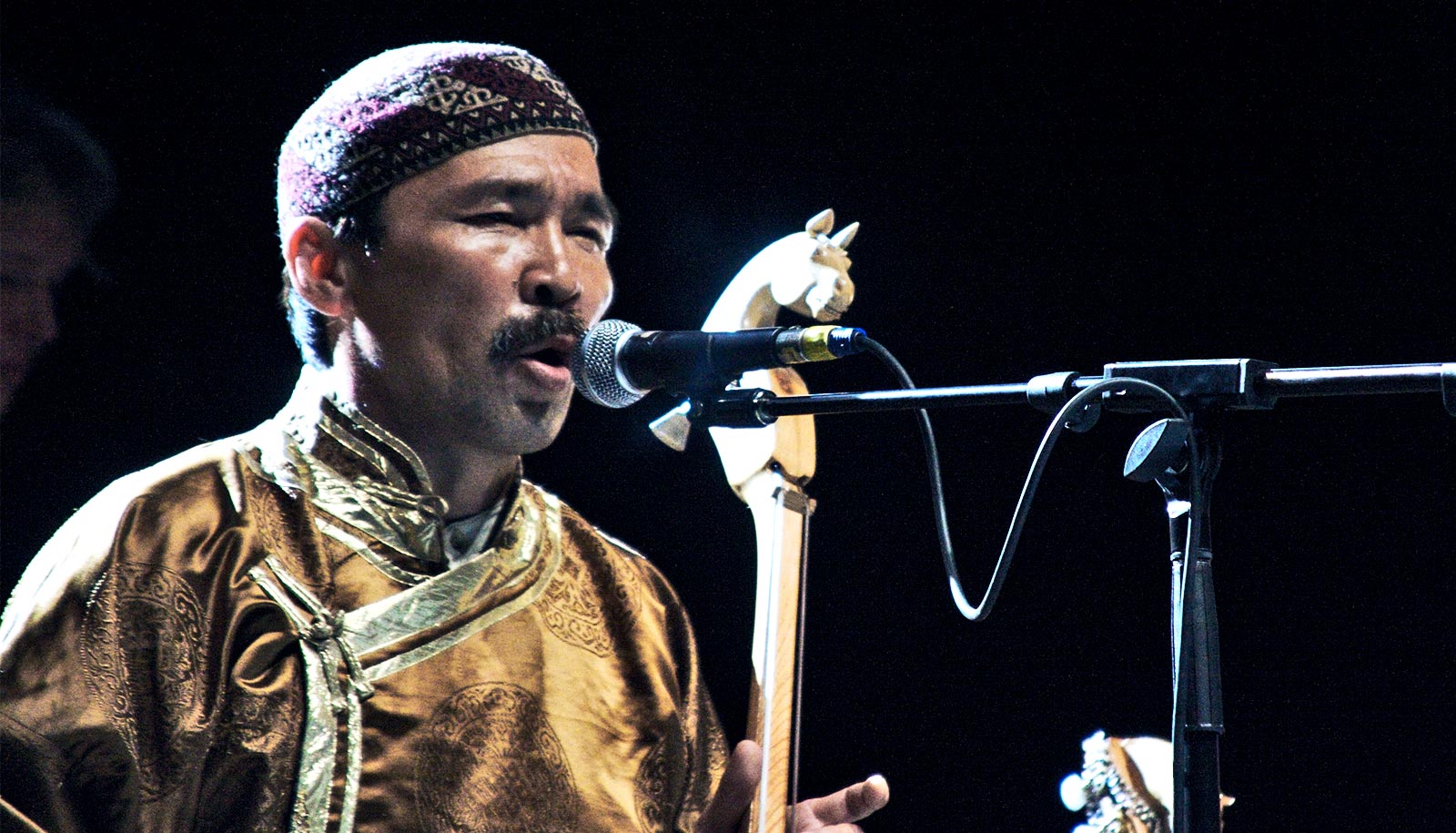New research offers insight into the vocal demands of contemporary musical theater.
The research employed a dosimeter device that monitors vocal vibrations the way a Fitbit tracks steps.
Vocal burnout in the performing arts isn’t rare. But nowhere are vocal demands greater, perhaps, than on Broadway. Singers there take on challenging roles, belting out show-stopping numbers eight or more times a week, and the heavy workload can take a toll.
The new research, which appears in the Journal of Voice, drew data from six student performers rehearsing for a production of Frank Wildhorn’s Wonderland, a theatrical spin on Lewis Carroll’s classic novel Alice’s Adventures in Wonderland.
Students fastened the dosimeter device—equipped with an accelerometer sensor—to their necks to capture vocal fold vibration data while singing in rehearsals. The data helped researchers measure the baseline “vocal dose” required for lead and ensemble roles in the show and compare it with the actual vocal output from student performers.

Vocal health professionals typically rely on a singer’s self-assessment of vocal discomfort to assess the likelihood of injury, but more definitive measurements with this kind of “vocal Fitbit” can help establish a threshold of vocal use that is sustainable for singers, as well as illustrate the vocal range required for each specific role in a production.
For example, the study illustrated how the student-performers used more of their “chest voice,”—meaning the lower range that uses thicker vocal folds and produces belting-like tone qualities through the speak-singing approach typical of contemporary musical theater. Today’s shows are more vocally and stylistically demanding than ever before, which can have an impact on a singer’s vocal anatomy over time, even potentially changing the underlying tissues.
While there are no hard-and-fast rules about how much singing is too much, this kind of data collection is paving the way for future research into the relationship between muscle fatigue and recovery time, and can empower performers to create healthy practices that minimize harm to the voice.
Here, leader of the study Ana Flavia Zuim, associate director of vocal performance at NYU Steinhardt and rehearsal pianist for Hamilton on Broadway, explains what she’s learned about performance demands young artists face today and the changes she hopes to see in the industry moving forward:
Why is it important to measure what performing in musical theater shows does to singers’ voices?
There’s a lot of misunderstanding about belting and Broadway and the vocal impact of singing a demanding role for eight shows a week. Belters use a vocal technique that requires a lot of what is known as chest voice, rather than head voice.
This study does for the voice what a Fitbit does for the body. A Fitbit might tell you that you burned 400 calories at the gym, while the accelerometer machine I used for the study tells you how many vibrations your voice produces per day and at what intensity—volume—and which pitches—frequencies—were produced with greater frequency throughout the day.
When we talk, treble voices or female voices speak at around 165-250 vibrations per second, depending on the speaker’s age. Male or non-treble voices speak at around 90-120 vibrations per second. When you’re singing, they go all the way up—some of the soprano notes can reach 1,000+ vibrations per second.
But when you’re belting, you are at a limited range that is lower than the soprano range—even though you might be a soprano—which means the mid-portion of the vocal folds are colliding more intensely than when singing in head voice. This study allowed us to see what is called the voice range profile, which tells us the intensity for the notes and frequencies used most frequently. The diagrams show blocks of darkness in the main frequency range with a little bit more lightness on the top and bottom notes that were used more sporadically.
This gives us a visual of the “vocal imprint” for some of these roles on Broadway so we can start to obtain an understanding of how “fit” a voice needs to be in order to endure roles of a certain caliber, particularly when a vocalist needs to perform eight shows a week. This is one of the very first studies of this nature, but once these dosimeter devices become more portable and compatible with phones, I expect we’ll see more studies like this one and more data to help us understand the impact of performance on vocal health.
What exactly is “belting?”
Belting has an urgent, calling sensation where the performers are pretty much yelling the note, and the vocal style conveys a lot of emotion. If you’ve heard Broadway songs like “Astonishing” [from Little Women], or finale songs that are loud, lavishing, and empowering, you’ll know what I’m talking about.
We understand belting as this powerful, guttural sound versus a more operatic sound. While both are demanding, belting is more demanding on the mid membrane of the vocal folds, and there’s more muscle involvement than ligament involvement. I previously did a study helping to destigmatize the idea that certain types of vocalisms generate certain types of pathology. Performers are vocal athletes, so singers from any style can be susceptible to injury.
But what we don’t know yet is the threshold of “how much is too much” and exactly how soon the fibers recover, especially with little to no vocal rest in between eight shows a week. We do know that different fibers recover at different speeds—one can recover in a few hours and another can take a day or two or three, depending on the body of the person—but there’s a lot left to discover.
What did you discover by measuring the vocal demands of roles in Wonderland?
This study helps demonstrate the vocal demand of the show in terms of the vocal range required: the lowest and highest notes required of the performer by the musical score. It also compares the vocal range of the score against the vocal range of the performer (how high and low their voice is capable of reaching) and helps us determine how much of their range the performer is actually using.
The week the student performers were using the accelerometer, we noticed that while the greatest amount of vocal usage concentration was within the limits of the score’s vocal range, in total singers used a much larger vocal range than was actually required by the score. This was probably because they engaged in warm up activities and sang other songs during rehearsal breaks.
What is the next phase of this research?
I’m embarking on a new study with Ingo Titze from the University of Utah, one of the best voice scientists in the country. In this study we ask belters to sing three different phrases in three different vowels around the belting region to create a graph (inertogram) that shows the peaks and valleys of energy in the voice throughout the range. By changing the mouth shape through vowel modification, you can actually turn a valley into a peak and vice versa. The graph will be based on mouth shape and face size, because the unique anatomical configurations of your face and throat give you a vocal print that is unique to you.
That’s why your voice might sound like that of your mother and your siblings. But it’s slightly different, because even though you may have some of the same features in terms of face and neck shape and size, there’s enough nuance in you to affect the frequency of your voice. This graph is going to help us understand how different individuals can change their mouth shape while vocalizing (such as using an “ahh” vs. an “ohh”) to produce a specific result in terms of vocal quality and impact. Your unique anatomy, as well as the ways you shape your mouth, act as a filter to the pitches you produce. By understanding how a person’s anatomy affects the way they vocalize, we can help vocalists to make changes in their mouth shape to produce a better boost to a particular note with less impact on their voice.
How have the vocal demands for performers shifted as musical theater scores evolved?
In the 1910s, the dominant form of musical theater was operetta, which was a lighter form of opera. As the decades went on, we witnessed the creation of burlesque, cabaret, and vaudeville which included more spoken word and lower vocal ranges. Eventually, we developed musicals with story throughlines. Oklahoma gave birth to the concept of a book musical—the plot of the story was intertwined with how the song was written. Ideas about the prosody of language and understanding how to communicate story through melody became more ingrained.
With the birth of the radio era, Broadway started influencing the radio. Rock and Elvis Presley became dominant and Broadway began adapting with the creation of Hair and Jesus Chris Superstar, among others. This led to jukebox musicals taking pre-existing pop songs from the radio and constructing a plot. Examples include Priscilla, Queen of the Desert, which used disco songs, ABBA musicals with Mamma Mia, and Jersey Boys, inspired by the Four Seasons. With rock, there’s a lot more of this calling, belting vocal style.
Hamilton was another huge transition, because now we have rap involved in musicals and the rap is telling the story. There’s no dialogue outside of musical content. It’s a difficult score—the Lafayette rap in “Guns and Ships” has more than six words per second. All these styles are intertwined on the Broadway stage, which creates artistic innovation but also requires different stamina from singers.
Vocal demands have changed drastically across genres and styles, requiring tremendous vocal versatility from Broadway performers. In academia, there was a longstanding tradition of teaching singing through opera or the bel canto traditions. But with this evolution of vocal styles we now are faced with the need to prepare students for the current vocal performance market. We must also help them understand how they can protect their vocal health and prevent injuries in the process.
What is the industry’s current attitude toward vocal health?
In opera, vocalists usually perform once or twice a week. Opera singers perform with greater intervals in between performances compared with Broadway performers. They also don’t tend to cast vocalists in major roles until they are in their thirties, which is when the voice is fully developed and mature enough to tackle demanding operatic roles. It’s a very different art form compared to musical theater.
On Broadway, there’s a lot of competition, and singers worry that if they call out too often, they might lose their contract to the person waiting in the wings. They push through even when they probably need a rest. It’s even more challenging for people on tour, because they’re traveling on top of rehearsing and performing eight shows a week. It has a huge impact on a performer’s body.
Surprisingly, work outside of performance is actually a major cause of vocal injury—more so than the performance itself. A lot of vocalists are trying to survive while auditioning through waiting tables or taking on other jobs that require the full use of their exuberant personalities. Those are “vocal roles” in the real world that have a cumulative effect on a performer’s voice.
What additional steps would you like to see Broadway take?
Many shows have a physical therapist on staff, but they don’t have a vocal expert. Some shows have vocal coaches or musical directors, but the mechanics of vocal technique is a specialized field. I would love for there to be greater awareness of vocal health and widespread dissemination of knowledge so there is more support for vocal health experts employed in stage shows. Matilda had a vocal coach on staff to warm up the kids and take care of their voices because they were still developing. But not a lot of shows do. I had the privilege of working with a few vocalists from Hamilton to help them find vocal strategies to manage the demands of the show, but I’m there mainly as a rehearsal pianist.
My dream would be if a portable, vocal Fitbit did exist and vocalists could wear that throughout the day so they could start seeing their own vocal exertion patterns. We could roll these out to singers working in the most vocally demanding Broadway shows and collect data that would better inform health interventions. For example, if a singer could see that they are singing high notes or belting in a specific range for extended periods of time, they could be empowered to create habits to help mitigate the effects of that. I always tell my students that I’m training them like they are vocal marathonists. There’s so much to understand in the minutia of voice, and they need to know how to protect themselves over the course of their long and illustrious careers.
Source: NYU



